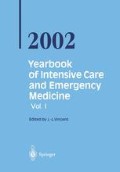Abstract
It is now generally accepted that whenever large volumes of saline are administered intravenously, metabolic acidosis can result [1–3]. Examples of at risk situations include acute normovolemic hemodilution, cardiopulmonary bypass, hypovolemic and septic shock, multitrauma, burns, liver transplantation, diabetic ketoacidosis and hyperosmolar non-ketotic coma. The conventional explanation is that there is simple dilution of extracellular bicarbonate (HCO -3 ) by large volumes of non-HCO -3 containing fluid [4–7]. However, Stewart’s physical-chemical approach to acid-base analysis provides a different perspective. In this chapter, we will see how Stewart’s concepts might assist in the design of crystalloid solutions with predetermined acid-base effects. We will begin by reviewing some important principles of acid-base analysis with an emphasis on the physical-chemical approach.
Access this chapter
Tax calculation will be finalised at checkout
Purchases are for personal use only
Preview
Unable to display preview. Download preview PDF.
References
Scheingraber S, Rehm M, Sehmisch C, Finsterer U (1999) Rapid saline infusion produces hyperchloremic acidosis in patients undergoing gynecologic surgery. Anesthesiology 90:1265–1270
McFarlane C, Lee A (1994) A comparison of Plasmalyte 148 and 0.9% saline for intra-op-erative fluid replacement. Anaesthesia 49:779–781
Prough DS, Bidani A (1999) Hyperchloremic metabolic acidosis is a predictable consequence of intraoperative infusion of 0.9% saline. Anesthesiology 90:1247–1249
Mathes DD, Morell RC, Rohr MS (1997) Dilutional acidosis: Is it a real clinical entity? Anesthesiology 86:501–503
Goodkin DA, Raja RM, Saven A (1990) Dilutional acidosis. South Med J 83:354–355
Garella S, Chang BS, Kahn SI (1975) Dilutional acidosis and contraction alkalosis: Review of a concept. Kidney Int 8:279–283
Prough DS (2000) Acidosis associated with perioperative saline administration. Dilution or delusion? Anesthesiology 93:1167–1169
Schwartz WB, Relman AS (1963) A critique of the parameters used in the evaluation of acid-base disorders. N Engl J Med 268:1382–1388
Narins RB, Emmett M (1980) Simple and mixed acid-base disorders: A practical approach. Medicine 59:161–187
Siggaard-Andersen O, Engel K (1960) A micro method for determination of pH, carbon dioxide tension, base excess and standard bicarbonate in capillary blood. Scand J Clin Lab Invest 12:172–176
Astrup P, Jorgensen K, Siggaard-Andersen O, et al (1960) Acid-base metabolism: New approach. Lancet 1:1035–1039
Siggaard-Andersen O, Fogh-Andersen N (1995) Base excess or buffer base (strong ion difference) as measure of a non-respiratory acid-base disturbance. Acta Anesth Scand Suppl 107:123–128
Stewart PA (1981) How to understand acid-base. In: Stewart PA (ed) A Quantitative Acid-base Primer for Biology and Medicine. Elsevier, New York, pp 1–286
Stewart PA (1983) Modern quantitative acid-base chemistry. Can J Physiol Pharmacol 61:1444–1461
Story DA, Liskaser F, Bellomo R (2000) Saline infusion, acidosis and the Stewart approach. Anesthesiology 92:624
Schlichtig R (1997) [Base excess] vs [strong ion difference]: Which is more helpful? Adv Exp Med Biol 411:91–95
Schlichtig R, Grogono AW, Severinghaus JW (1998) Current status of acid-base quantitation in physiology and medicine. Anesthesiol Clin North Am 16:211–233
Rossing TH, Maffeo N, Fencl V (1986) Acid-base effects of altering plasma protein concentration in human blood in vitro. J Appl Physiol 61:2260–2265
Wilkes P (1998) Hypoproteinemia, strong-ion difference, and acid-base status in critically ill patients. J Appl Physiol 84:1740–1748
LeBlanc M, Kellum J (1998) Biochemical and biophysical principles of hydrogen ion regulation. In: Ronco C, Bellomo R (eds) Critical Care Nephrology. Kluwer Academic Publishers, Dordrecht, pp 261–277
Miller LR, Waters JH (1997) Mechanism of hyperchloremic nonanion gap acidosis. Anesthesiology 87:1009–1010
Storey DA (1999) Intravenous fluid administration and controversies in acid-base. Crit Care Resuscitation 1:151–156
Makoff DL, da Silva JA, Rosenbaum BJ, Levy SE, Maxwell MH (1970) Hypertonic expansion: acid-base and electrolyte changes. Am J Physiol 218:1201–1207
Morgan TJ, Venkatesh B, Hall J (2002) Crystalloid strong ion difference determines metabolic acid-base change during in vitro hemodilution. Crit Care Med (in press)
White SA, Goldhill DR (1997) Is Hartmann’s the solution? Anaesthesia 52:422–427
Hartmann AF, Senn MJ (1932) Studies in the metabolism of sodium r-lactate. 1. Response of normal human subjects to the intravenous injection of sodium r-lactate. J Clin Invest 11:337–344
Dorje P, Adhikary G, Tempe DK (2000) Avoiding iatrogenic hyperchloremic acidosis — call for a new crystalloid fluid. Anesthesiology 92:625–626
Morgan TJ (1999) The significance of the P50. In: Vincent JL (ed) Yearbook of Intensive Care and Emergency Medicine. Springer-Verlag, Heidelberg pp 433–447
Morgan TJ, Koch D, Morris D, Clague A, Purdie DM (2001) Red cell 2,3-diphosphoglyce-rate concentrations are reduced in critical illness without net effect on in vivo P50. Anaesth Intensive Care 29:479–483
Forrest DM, Walley KR, Russell JA (1998) Impact of acid-base disorders on individual organ systems In: Ronco C, Bellomo R (eds) Critical Care Nephrology. Kluwer Academic Publishers, Dordrecht, pp 313–326
Traverso LW, Lee WP, Langford MJ (1986) Fluid resuscitation after an otherwise fatal hemorrhage: 1. Crystalloids solutions. J Trauma 26:168–175
Liskaser FJ, Bellomo R, Hayhoe M, et al (2000) Role of pump prime in the etiology and pathogenesis of cardiopulmonary bypass-associated acidosis. Anesthesiology 93:1170–1173
Editor information
Editors and Affiliations
Rights and permissions
Copyright information
© 2002 Springer-Verlag Berlin Heidelberg
About this paper
Cite this paper
Morgan, T.J., Venkatesh, B. (2002). Strong Ions, Acid-base, and Crystalloid Design. In: Vincent, JL. (eds) Yearbook of Intensive Care and Emergency Medicine 2002. Yearbook of Intensive Care and Emergency Medicine 2002, vol 2002. Springer, Berlin, Heidelberg. https://doi.org/10.1007/978-3-642-56011-8_39
Download citation
DOI: https://doi.org/10.1007/978-3-642-56011-8_39
Publisher Name: Springer, Berlin, Heidelberg
Print ISBN: 978-3-540-43149-7
Online ISBN: 978-3-642-56011-8
eBook Packages: Springer Book Archive

